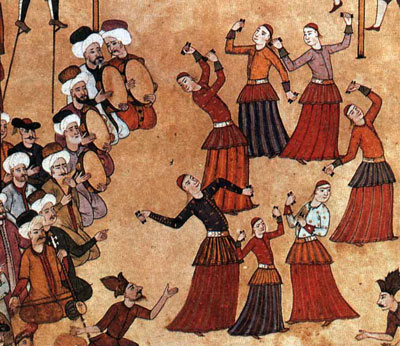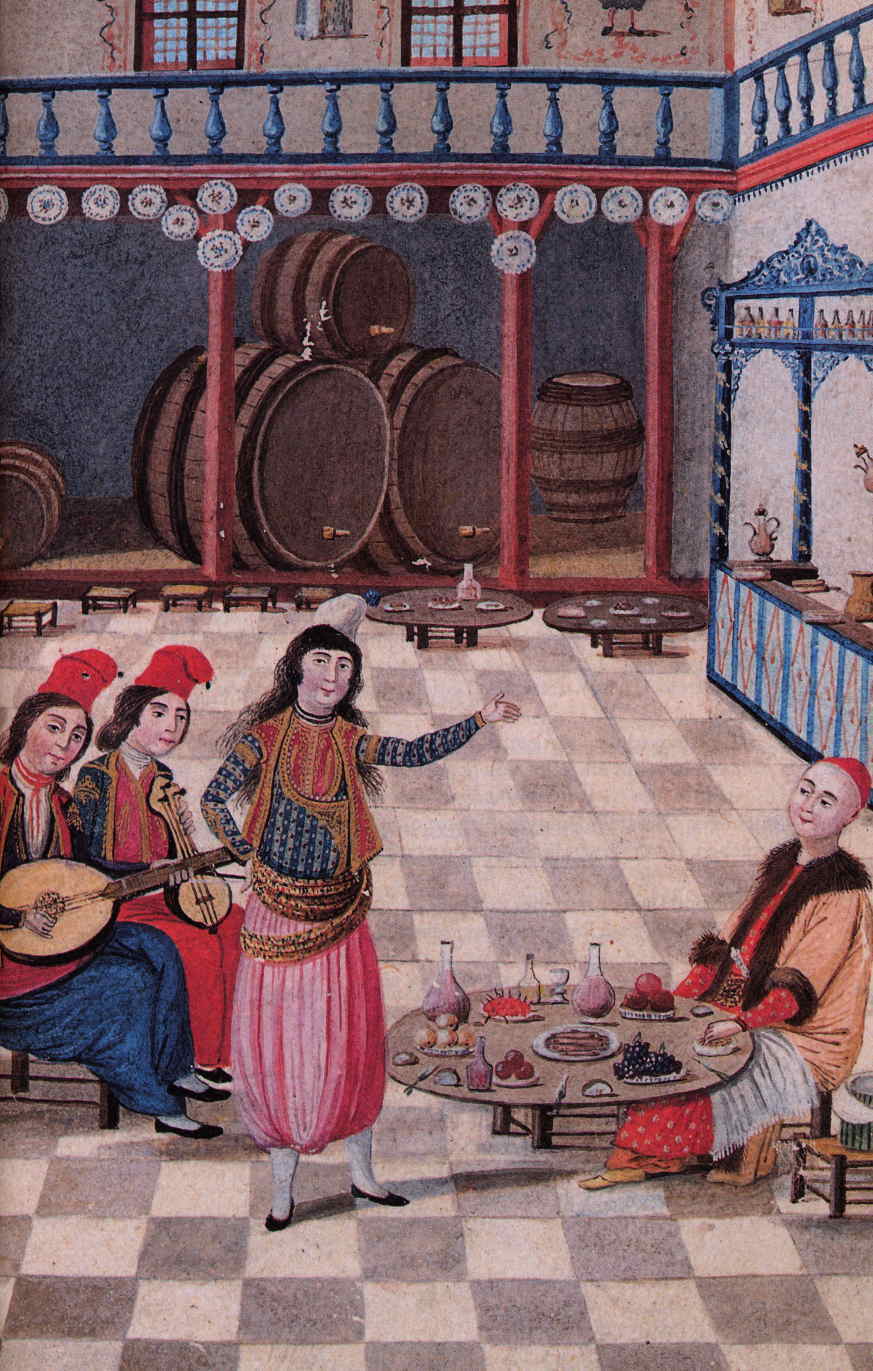Köçek on:
[Wikipedia]
[Google]
[Amazon]
The ''köçek'' (plural in Turkish) was typically a very handsome young male slave or a Romani dancer (''rakkas''), who usually cross-dressed in feminine attire, and was employed as an 
 The
The
 A ''köçek'' would begin training around the age of seven or eight after he was circumcised and would be considered accomplished after about six years of study and practice. A dancer's career would last as long as he was clean shaven and retained his youthful appearance.
The dances, collectively known as ''köçek oyunu'', blended elements from throughout the empire, most importantly Turkish (like Karsilamas and Kaşık Havası) and
A ''köçek'' would begin training around the age of seven or eight after he was circumcised and would be considered accomplished after about six years of study and practice. A dancer's career would last as long as he was clean shaven and retained his youthful appearance.
The dances, collectively known as ''köçek oyunu'', blended elements from throughout the empire, most importantly Turkish (like Karsilamas and Kaşık Havası) and
Turkish Cultural Foundation: Court dance in the Ottoman EmpireA Question of Köçek – Men in Skirts
{{DEFAULTSORT:Kocek Turkish male dancers Transgender in the Middle East Middle Eastern culture Arab culture Belly dance Gender systems Turkish sex workers 18th century in LGBT history 19th century in LGBT history Turkish words and phrases Slaves from the Ottoman Empire LGBT in Turkey Cross-dressing Transgender in Europe Male erotic dancers Islam and slavery Sexual slavery
entertainer
An entertainer is someone who provides entertainment in various different forms.
Types of entertainers
* Acrobat
* Actor
* Archimime
* Athlete
* Barker
* Beatboxer
* Benshi
* Bouffon
* Circus performer
* Clown
* Club Hostess/Host
* Co ...
.

Roots
 The
The Persian
Persian may refer to:
* People and things from Iran, historically called ''Persia'' in the English language
** Persians, the majority ethnic group in Iran, not to be conflated with the Iranic peoples
** Persian language, an Iranian language of the ...
word ''kuchak'' derives itself from Turkish ''küçük'' meaning "little", "small", or "young". In the Crimean Tatar language, the word ''köçek'' means "baby camel".
The culture of the ''köçek'', which flourished from the 17th to the 19th century, had its origin in the customs in Ottoman palaces, and in particular in the harems
Harem (Persian: حرمسرا ''haramsarā'', ar, حَرِيمٌ ''ḥarīm'', "a sacred inviolable place; harem; female members of the family") refers to domestic spaces that are reserved for the women of the house in a Muslim family. A har ...
. Its genres enriched both the music and the dance of the Ottomans.
The support of the Sultans was a key factor in its development, as the early stages of the art form was confined to palace circles. From there the practice dispersed throughout the Empire by means of independent troupes.
Culture
Arab
The Arabs (singular: Arab; singular ar, عَرَبِيٌّ, DIN 31635: , , plural ar, عَرَب, DIN 31635: , Arabic pronunciation: ), also known as the Arab people, are an ethnic group mainly inhabiting the Arab world in Western Asia, ...
elements. They performed to a particular genre of music known as ''köçekçe'', which was performed in the form of suites in a given melody. It too was a mix of Sufi, Balkan and classical Anatolian influences, some of which survives in popular Turkish music today. The accompaniment included various percussion instruments, such as the ''davul-köçek'', the davul
The davul, dhol, tapan, atabal or tabl is a large double-headed drum that is played with mallets. It has many names depending on the country and region. These drums are commonly used in the music of the Middle East and the Balkans. These drums ...
being a large drum, one side covered with goat skin and the other in sheep skin, producing different tones. A ''köçek''s skill would be judged not only on his dancing abilities but also on his proficiency with percussion instruments, especially a type of castagnette known as the ''çarpare''. The dancers were accompanied by an orchestra, featuring four to five each '' kaba kemençe'' and ''laouto
The laouto ( el, λαούτο, pl. laouta ) is a long-neck fretted instrument of the lute family, found in Greece and Cyprus, and similar in appearance to the oud. It has four double-strings. It is played in most respects like the oud (plucked ...
'' as principal instruments, used exclusively for ''köçek'' suites. There were also two singers. A ''köçek'' dance in the Ottoman seraglio
A seraglio, serail, seray or saray (from fa, سرای, sarāy, palace, via Turkish and Italian) is a castle, palace or government building which was considered to have particular administrative importance in various parts of the former Ott ...
(palace harem) involved one or two dozen ''köçeks'' and many musicians. The occasions of their performances were wedding or circumcision celebrations, feasts and festivals, as well as the pleasure of the sultans and the aristocracy.
The youths, often wearing heavy makeup, would curl their hair and wear it in long tresses under a small black or red velvet hat decorated with coins, jewels and gold. Their usual garb consisted of a tiny red embroidered velvet jacket with a gold-embroidered silk shirt, ''shalvar'' (baggy trousers), a long skirt and a gilt belt, knotted at the back. They were said to be "sensuous, attractive, effeminate", and their dancing "sexually provocative". Dancers minced and gyrated their hips in slow vertical and horizontal figure eights, rhythmically snapping their fingers and making suggestive gestures. Often acrobatics, tumbling and mock wrestling
Wrestling is a series of combat sports involving grappling-type techniques such as clinch fighting, throws and takedowns, joint locks, pins and other grappling holds. Wrestling techniques have been incorporated into martial arts, combat ...
were part of the act.
Famous poets, such as Fazyl bin Tahir Enderuni, wrote poems, and classical composers, such as the court musician Hammamizade İsmail Dede Efendi (1778–1846), composed ''köçekçes'' for celebrated ''köçeks''. Many Istanbul meyhane
A ''meyhane'' (from Persian: میخانه translit. ''meykhaneh'') is a traditional restaurant or bar in Turkey and rest of the Balkans, Azerbaijan and Iran. It serves alcoholic beverages like wine, rakı, vodka, beer with meze and tradition ...
s (nighttime taverns serving ''meze
Meze or mezza (, ) is a selection of small dishes served as appetizers in the Levantine cuisine, Levant, Turkish cuisine, Turkey, Greek cuisine, Greece, the Balkan cuisine, Balkans, the Caucasian cuisine, Caucasus and Iranian cuisine, Iran. It i ...
'', '' rakı'' or wine) hired ''köçeks''. Before starting their performance, the ''köçek'' danced among the spectators, to make them more excited. In the audience, competition for their attention often caused commotions and altercations. Men would allegedly go wild, breaking their glasses, shouting themselves voiceless, or fighting and sometimes killing each other vying for the opportunity to rape, molest, or otherwise force the children into sexual servitude. This resulted in suppression of the practice under Sultan Abdulmejid I
Abdulmejid I ( ota, عبد المجيد اول, ʿAbdü'l-Mecîd-i evvel, tr, I. Abdülmecid; 25 April 182325 June 1861) was the 31st Sultan of the Ottoman Empire and succeeded his father Mahmud II on 2 July 1839. His reign was notable for the r ...
.
As of 1805, there were approximately 600 ''köçek'' dancers working in the taverns of the Turkish capital. They were outlawed in 1837 due to fighting among audience members over the dancers. With the suppression of harem culture under Sultan Abdulaziz (1861–1876) and Sultan Abdul Hamid II (1876–1908), ''köçek'' dance and music lost the support of its imperial patrons and gradually disappeared.
''Köçeks'' were much more sought after than the ''çengi'' ("belly dance
Belly dance (Egyptian Arabic: رقص بلدي, translated: Dance of the Country/Folk Dance, romanized: Raks/Raas Baladi) is a dance that originates in Egypt. It features movements of the hips and torso. It has evolved to take many different f ...
rs"), their female counterparts. Some youths were known to have been killed by the ''çengi'', who were extremely jealous of men's attention toward the boys.
= Dance and Music =
''Köçek'' dancers ranged from ten to eighteen years old. Their attire consisted of wearing colorful garments, makeup, perfume and long hair. They were tasked with entertaining their superiors through dance, music, singing and performing acrobatics.
Aside from dancing, ''köçeks'' were required to play instruments simultaneously. They used ''dâire'' (Arabic for “circle”) which is similar to a drum, a ''çaǧana'' (Persian origin) that were metal castanets, and ''çelpara'' (Persian for “four pieces”), also known as ''çârpâra'', clappers. Vocally, they used ''ince sâz'' (soft sounding instruments) consisting of ''kemençe rumî'' (fiddle) and ''lavta'' (lute).
Lyrics and poems were written about the ''köçek'', describing their performances, mentioning their coquettish ways and charm. Derived from that, came the ''köçekçe'', becoming a musical phenomena as they performed in ensembles.
= Lifestyle =
Education was provided to the ''köçek'' at ''enderȗn mektebi'' (the school of the palace) and only some were chosen to live in the inner part of the sultan’s palace. Others resided elsewhere and worked in the ''kol'' (in the guilds of craftsmen).
''Köçeks'' were recruited of several background and ways, such as by captives, slaves or ''devşirme'' (recruiting of boys from the Janissary corps) from the fourteenth to early eighteenth century.
They performed at varying sultan festivities, presented to ambassadors and showed their skills at taverns, wine cellars and coffee shops for money.
Modern offshoots
A modern interpretation is the movie '' Köçek'' (1975) by director Nejat Saydam. The movie follows the life of Caniko, an androgynous Gypsy, who struggles with his gender identity.See also
*Bacha bazi
''Bacha bāzī'' ( fa, بچه بازی, lit. "boy play"; from ''bacheh'', "boy", and ''bazi'' "play, game") is a slang term used in Afghanistan for a custom in Afghanistan involving child sexual abuse by older men of young adolescent males or b ...
, Afghan equivalent
*Khawal, Egyptian equivalent
*Ghilman
*LGBT topics and Islam
Notes
References
*AYVERDİ, Sâmiha; Istanbul Geceleri ''The nights of Istanbul'', ed. Baha, Istanbul, 1977. *ENDERUNLU Fazıl bey; ''Çenginame, 1759 *Erdoğan, Sema Nilgün: ''Sexual life in Ottoman Empire'', ed. Dönence, Istanbul, 1996. p. 88–92 *JANSSEN, Thijs: ''Transvestites and Transsexuals in Turkey'', in ''Sexuality and Eroticism Among Males in Moslem Societies'', edited by Arno Schmidt and Jehoeda Sofer, ed. Harrington Park Press, New York, 1992 *Klebe, Dorit. "Effeminate Professional Musicians in Sources of Ottoman-Turkish Court Poetry and Music of the Eighteenth and Nineteenth Centuries.” ''Music in Art'' 30, no. 1/2 (2005): 97–116. *KOÇU, Reşad Ekrem, ''Eski İstanbul'da Meyhaneler ve Meyhane Köçekleri, İstanbul Ansiklopedisi Notları No'' *ÖZTUNA, Yılmaz: ''Türk Musikisi Ansiklopedisi'', Milli Eğitim Basımevi, İstanbul, 1976. p. 23 *S.M. ÜSEINOV: ''Rusça-Qırımtatarca, Qırımtatarca-Rusça luğat'', Aqmescit, Tezis, 2007.External links
Turkish Cultural Foundation: Court dance in the Ottoman Empire
{{DEFAULTSORT:Kocek Turkish male dancers Transgender in the Middle East Middle Eastern culture Arab culture Belly dance Gender systems Turkish sex workers 18th century in LGBT history 19th century in LGBT history Turkish words and phrases Slaves from the Ottoman Empire LGBT in Turkey Cross-dressing Transgender in Europe Male erotic dancers Islam and slavery Sexual slavery